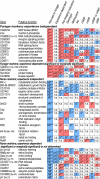Genomic dissection of behavioral maturation in the honey bee
- PMID: 17065327
- PMCID: PMC1622924
- DOI: 10.1073/pnas.0606909103
Genomic dissection of behavioral maturation in the honey bee
Abstract
Honey bees undergo an age-related, socially regulated transition from working in the hive to foraging that has been previously associated with changes in the expression of thousands of genes in the brain. To understand the meaning of these changes, we conducted microarray analyses to examine the following: (i) the ontogeny of gene expression preceding the onset of foraging, (ii) the effects of physiological and genetic factors that influence this behavioral transition, and (iii) the effects of foraging experience. Although >85% of approximately 5,500 genes showed brain differences, principal component analysis revealed discrete influences of age, behavior, genotype, environment, and experience. Young bees not yet competent to forage showed extensive, age-related expression changes, essentially complete by 8 days of age, coinciding with previously described structural brain changes. Subsequent changes were not age-related but were largely related to effects of juvenile hormone (JH), suggesting that the increase in JH that influences the hive bee-forager transition may cause many of these changes. Other treatments that also influence the onset age of foraging induced many changes but with little overlap, suggesting that multiple pathways affect behavioral maturation. Subspecies differences in onset age of foraging were correlated with differences in JH and JH-target gene expression, suggesting that this endocrine system mediates the genetic differences. We also used this multifactorial approach to identify candidate genes for behavioral maturation. This successful dissection of gene expression indicates that, for social behavior, gene expression in the brain can provide a robust indicator of the interaction between hereditary and environmental information.
Conflict of interest statement
The authors declare no conflict of interest.
Figures




Comment in
- Proc Natl Acad Sci U S A. 103:16065.
References
Publication types
MeSH terms
Substances
Grants and funding
LinkOut - more resources
Full Text Sources
Medical
Molecular Biology Databases

